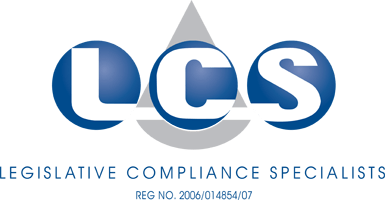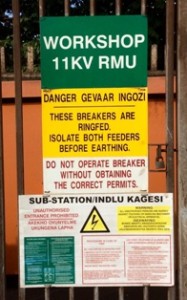The period under review contained notices impacting on both the OHSA and MHSA spheres of application.
In terms of the Occupational Health and Safety Act, the most important notification concerns the mandatory drafting of Health and Safety Policies by employers. The notice directs that employers in Class 11, which includes medical facilities, to draft a policy within two years.
In terms of the Mine Health and Safety Act, the major news is the wholesale repeal of Chapter 21, electricity. This is replaced with a new Chapter 3 under the Mine Health and Safety Act Regulations. The impact of this is obvious, as all mining operations will be affected. Some of the less obvious issues to take note of includes the requirement for new/updated legal appointments based on the new Regulations. This comes on the back of new Machinery Regulations (under Chapter 8 of the Mine Health and Safety Act Regulations) that deal specifically with Trackless Mobile Machinery. These Regulations, also far reaching in terms of their scope, are set to come into operation on 27 May. Our recent interactions with clients indicate that not all of the less obvious requirements are fully understood, as a lot of focus has been placed on the requirements for the use Collision Avoidance (CA) systems. This is by no means the only area that will have to be focused on in terms of ensuring compliance!
As mentioned in previous updates, LCS has designed a one day TMM Compliance Audit to identify the state of readiness of mining operations for the new Regulations as well list those areas to be addressed. We also include comments on some other amendments which will have an indirect impact on health and safety legal liability.
Regards, Jaco Swartz
The Minister of Mineral Resources published new Electrical Regulations. A Notice on the same day repealed Chapter 21 of the Minerals Act Regulations. The first point to note is that the structure of the new Regulations is simplified when compared to the previous Regulations, as it only contains 39 respective Regulations versus the approximately 63 distinct Regulations previously. In addition, the new Regulations contain definitions which were not defined in the previous Regulations. These include definitions for bus coupler, circuit, domestic voltage and lockout-tagout amongst others. The approach to more clearly defining wording in the Regulations should be welcomed as it should limit ambiguity. The first portion of the new Regulations deal with the specific responsibility for electrical equipment. It states that a competent person(s) must take responsibility electrical equipment. Amendments have also been made to Chapter 22, Technical Competencies, which defines what “competent person” means in each example:
Two issues will have to be dealt with in order to ensure compliance. The first would be to ensure that current legal appointments reflect this, while the competence of the appointees will have to be verified. The Regulations place a general duty on the employer to prevent any accident related to arc flashes, electrocution and electrical shock. Some of the issues dealt with in terms of this includes: 1. taking into account electrical failure due to electromagnetic interference, 2. competent person approval for extensions of electrical reticulation designs, 3. only competent, authorised persons be permitted to perform switching, energising, de-energising and isolation (note legal appointment and authorisation required) 4. installation of back-up electrical supply where failure of electrical supply is critical to equipment, 5. ensuring that electrical apparatus locations are well ventilated, well lit, fitted with lockout facilities, fitted with fire extinguishers etc. 6. Substations, as far as is reasonably practicable, be equipped with up to date single line drawings of reticulation 7. Substations to be fitted with signage and effective means of communication The Regulations deal with specific areas of application, including underground installations in general and installations in coal mines specifically. In addition, the Regulations deal with entry into areas where electrical apparatus is situated. The requirement is that only competent (see tables above) authorised persons (implying a written authorisation) enter areas where live equipment is situated, but states that such a person may be assisted, in an emergency, by a person who is not “competent”. In our opinion the reference to an emergency is broad and should be defined in a procedure or SOP. The new Regulation 3.3.3 refers to a “competent person” to perform energising, de-energising and isolation. This person’s competence is defined in the amendments to Chapter 22:
In addition to the points briefly discussed above, some of the other matters dealt with include: 1. requirements for testing after isolation, 2. equipment which may inadvertently become live, 3. prohibition of metallic ladders, 4. drafting of mandatory isolation procedure, 5. requirements for flexible and trailing cables, 6. contact between mobile equipment and overhead lines, 7. incorporation of SANS 10142-1 for the wiring of premises for surface buildings, 8. incorporation of SANS 10280 for overhead power lines, 9. incorporation of SANS 1438 in terms of helmet light assemblies, 10. requirement for certification of all electrical equipment in a hazardous area to be certified by an accredited test laboratory, 11. requires documentation to be held by the manager for all explosion protected equipment. In summary, the new Regulations should be welcomed as they modernise and streamline the previous requirements. It should also be seen as removing some uncertainty as to how electrical issues are dealt with, especially against the backdrop of the legal requirements outside of the mining industry. As always, however, change brings legal risk. We suggest active steps are to be taken to ensure that all requirements are met, and that proof is available that they have been met. This implies updating and drafting new legal appointments (and “authorizations”), updating COP’s and SOP’s, reviewing risk assessments and ensuring that all responsible persons are made aware of the changes.
Two Notices were published in terms of the COID Act. These Notices increase the minimum pension in terms of Section 83(8) to R 1 500. It also increases the payable pensions to spouses and dependants.
The Department of Higher Education and Learning has published proposed occupational qualifications for comment. The import from a liability point of view is that registered qualifications may (under both the OHSA and MHSA) become legal requirements for minimum competence. Some of the proposed qualifications include: 1. Master tool maker, 2. Diesel fitter, 3. Diesel mechanic, 4. Heavy equipment mechanic, and 5. Millwright. Interested parties are invited to comment before 19 May 2015.
The Chief Inspector, Mr. Tibor Szana, has issued a directive in terms of Section 7 of the Act. Section 7 deals with the drafting of a Health and Safety Policy by Employer. There is a general misconception that all Employers have a legal duty to draft and implement a Health and Safety policy. A policy only becomes a legal requirement once a specific industry sector has been directed to compile it. The directive in question applies to sector 11, the Medical Services and Animal Hospital industry. Operations will include dentists, radiologists, ambulance associations, dog breeders, veterinary surgeons and pet dealers amongst others. These employers must, in their policies: 1. describe the organisation of work, 2. explain the implementation and review of the policy. In terms of Section 7(2), the Chief Inspector must issue guidelines for the compilation of the policy. The Notice, in compliance with this duty, specifically references OHSAS 18001 and 18002. Note that this does not make the adoption of the standards compulsory, but indicates that these standards may be consulted when drafting a policy. The listed Employers have two years within which to comply with the directive.
A Notice was Gazetted stating the intention to amend the compulsory specification for Personal Protective Equipment – Safety Footwear. Any manufacturer in terms of Section 10 of the OHSA and Section 21 of the MHSA will be bound by potential amendments to the mandatory standard. Note that manufacturer under both sets of legislation will include importers, suppliers and retailers. Comments on the proposed amendments must be delivered before 24 June 2015
1. Schedule 1: New Standards Some of the more important new standards include: · SANS 1515-3-1: 2015 Gas measuring equipment for use in mines, instruments an devices · SANS 18091: 2015 Quality Management Systems, guidelines for the use of ISO 9001: 2008 in local government · SATR 29944: 2015 Powered industrial Trucks and Tractors, Brake performance 2. Schedule 2: Amendment of existing standards Some of the more important amended standards include: · SANS 256: 2015 Fire protection for electronic equipment installations · SANS 10263-2: 2015 Warehousing of dangerous goods, storage and handling of gas cylinders · SANS 60079: 2015 Explosive atmospheres 3. Schedule 3: Cancellation of standards The following standards have been cancelled · SANS 728-8: 2009 Automatic fire detection systems, multi point aspirated smoke detectors 4. Schedule 4: Contact details This has remained unchanged. FOR ANY FURTHER INFORMATION, COMMENTS OR QUERIES, PLEASE DO NOT HESITATE TO CONTACT THE WRITER Regards, Jaco Swartz Managing Director Legislative Compliance Specialists (Pty.) Ltd. |
||||||||||||||||||||||||||||||||||||||||||||||||||||||||||||||||||||||||||||||||||||||||||||||||||||||||||||||||||||||||||||||||||||||||||||||||||||||||||||||||||||||||||||||||||||||||||||||||||||||||||||


Please advise – Where will I find the update of MHSA Regulations in Chapter 22 regarding thecompetencies in the new Chapter 3 Electrical Regulations?
Thanks,
Rory McLoughlin
Hi Rory, will contact you via mail.